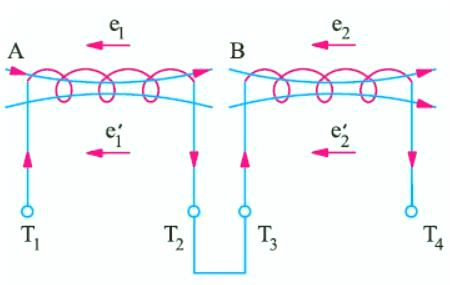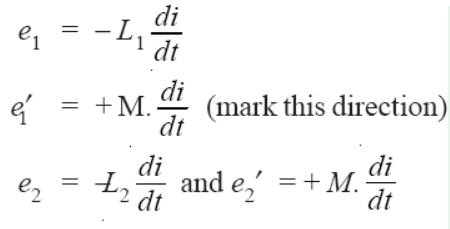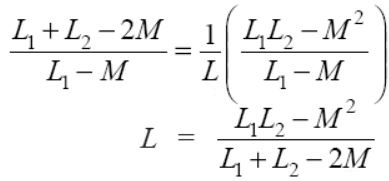Inductances in Series and Parallel
Inductances in Series
(i) Let the two coils be so joined in series that their fluxes (or m.m.fs) are additive i.e., in the same direction (Fig. 7.14).
Let M = coefficient of mutual inductance
L1 = coefficient of self-inductance of 1st coil
L2 = coefficient of self-inductance of 2nd coil.
Then, self induced e.m.f. in A is

Mutually-induced e.m.f. in A due to change of current in B
is

Self-induced e.m.f. in B is ![]()
Mutually-induced e.m.f. in B due to change of current in A is ![]()
(All have −ve sign, because both self and mutally induced e.m.fs. are in opposition to the applied e.m.f.). Total induced e.m.f. in the combination
![]()
If L is the equivalent inductance then total induced e.m.f. in that single coil would have been
![]()

Equating (i) and (ii) above, we have L = L1 + L2 + 2M
(ii) When the coils are so joined that their fluxes are in opposite directions (Figure given below).

∴ Equivalent inductance
L = L1 + L2 − 2M
In general, we have :
L = L1 + L2 + 2M . ………………. if m.m.fs are additive
and L = L1 + L2 − 2M ……………… if m.m.fs. are subtractive
AdBlock-2

Inductance in Parallel
In Figure given below, two inductances of values L1 and L2 henry are connected in parallel. Let the coefficient of mutual inductance between the two be M. Let i be the main supply current and i1 and i2 be the branch currents
Obviously, i = i1 + i2
![]()

In each coil, both self and mutually induced e.m.fs. are produced. Since the coils are in parallel, these e.m.fs. are equal. For a case when self-induced e.m.f.,
we get

If L is the equivalent inductance, then ![]()
= induced e.m.f. in the parallel combination
= induced e.m.f. in any one coil 
![]()
Substituting the value of di1/dt from (ii) in (iv), we get ![]()
Hence, equating (iii) to (iv), we have 

when mutual field assists the separate fields.
Similarly,  when the two fields oppose each other.
when the two fields oppose each other.
Read article – self-inductance
Visit NCERTplanet.com for NCERT solutions and Textbook downloads




